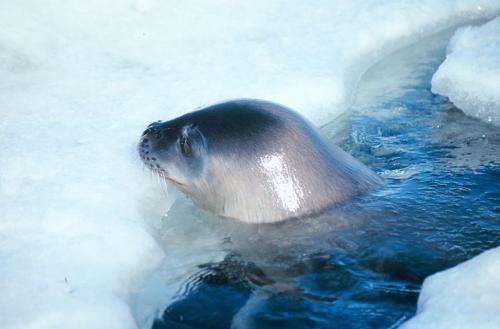January 20, 2017 weblog
Seals found able to find hidden fish by using whiskers to trace aspiration currents

A team of researchers with the University of Rostock in Germany has found that seals are able to use their whiskers to find fish hiding in the sand on the ocean floor. In their paper published in the Journal of Experimental Biology, the team describes experiments they carried out with seals in a near-native environment and what they learned from them.
Prior research has shown that seals are able to track swimming fish using their sensitive whiskers by noting slight changes in the water behind swimming fish. In this new effort, the researchers have found that seals are able to use their whiskers to find prey hiding in the sand on the bottom of the ocean, as well.
Scientists have known for some time that seals are able to somehow sense and find fish hiding in the sand on the bottom of the sea, even when the water is murky, but until now, no one knew how they did it. To find out, the researchers trapped several seals using nets in a section of the Baltic Sea and then conducted several experiments with them.
The experiments consisted of installing very small water pumps around the sea floor to simulate the extraordinarily tiny current created by a fish as water passes through its gills. The researchers then tested the seals on their ability to find the pumps under various conditions—with their eyes covered or uncovered, their whiskers covered or uncovered and their entire faces covered or uncovered—and with clear or turbid water.
The researchers found that the seals were able to find the pumps approximately 90 percent of the time regardless of water clarity if they were left unrestricted. When blindfolded, they were still able to find the pumps approximately 75 percent of the time. With their whiskers covered, however, the seals were no longer able to find the fish, and in fact, did not even try.
Still unclear, the researchers note, is if some fish have developed an ability to hold their breath when they notice seals coming close. More research is required to find out.
More information: Benedikt Niesterok et al. Hydrodynamic detection and localization of artificial flatfish breathing currents by harbour seals (), The Journal of Experimental Biology (2017). DOI: 10.1242/jeb.148676
ABSTRACT
Harbour seals are known to be opportunistic feeders, whose diet consists mainly of pelagic and benthic fish, such as flatfish. As flatfish are often cryptic and do not produce noise, we hypothesized that harbour seals are able to detect and localize flatfish using their hydrodynamic sensory system (vibrissae), as fish emit water currents through their gill openings (breathing currents). To test this hypothesis, we created an experimental platform where an artificial breathing current was emitted through one of eight different openings. Three seals were trained to search for the active opening and station there for 5 s. Half of the trials were conducted with the seal blindfolded with an eye mask. In blindfolded and non-blindfolded trials, all seals performed significantly better than chance. The seals crossed the artificial breathing current (being emitted into the water column at an angle of 45 deg to the ground) from different directions. There was no difference in performance when the seals approached from in front, from behind or from the side. All seals responded to the artificial breathing currents by directly moving their snout towards the opening from which the hydrodynamic stimulus was emitted. Thus, they were also able to extract directional information from the hydrodynamic stimulus. Hydrodynamic background noise and the swimming speed of the seals were also considered in this study as these are aggravating factors that seals in the wild have to face during foraging. By creating near-natural conditions, we show that harbour seals have the ability to detect a so-far overlooked type of stimulus.
Journal information: Journal of Experimental Biology
© 2017 Phys.org


















